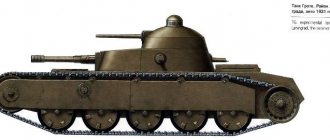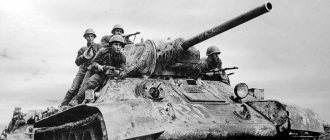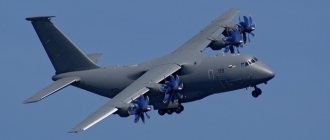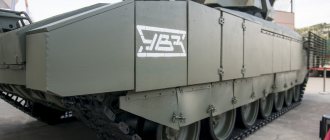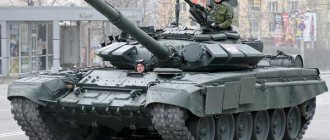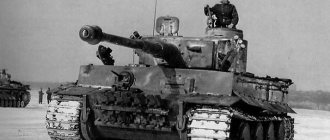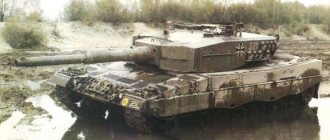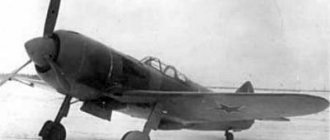Tank Grote - “the result of politics and the victim of technology”
Perhaps nowhere else has ideology had such an influence on the processes of creating armored weapons as in the USSR. Moreover, everything, in general, was good until “Black Thursday” on October 24, 1929. This day is considered the day of the beginning of the global economic crisis. True, there was still a short-term rise in prices on October 25, but then the fall took a catastrophic turn on “Black Monday” (October 28), and then “Black Tuesday” (October 29). October 29, 1929 is considered the day of the Wall Street Crash. Throughout the year, the US economy gradually collapsed, until at the end of 1930 depositors began to withdraw their money from banks in large numbers, which also led to bank bankruptcy and a wild contraction of the money supply. The second banking panic occurred in the spring of 1931...
Tank TG. Photo from 1940.
Well, how did the USSR react to all this? Already on December 27, 1929, Stalin, in his speech at the conference of Marxist agrarians, called for the transition to a policy of complete collectivization of agriculture and the elimination of the kulaks as a class. And already on December 30, 1929, I. Khalepsky’s commission went abroad to “buy tanks.” At the same time, negotiations began in Germany with the goal of inviting knowledgeable BTT design specialists to work in the USSR.
The connection between all these events is obvious. Before this, there was a decline in the revolutionary wave in the West, and in the USA they started talking about the “period of prosperity”, the revolutions in Germany and Hungary suffered defeats, and now only the newspaper Pravda wrote about the world revolution, and Makar Nagulnov dreamed in Sholokhov "Virgin Soil Upturned" And then suddenly there was a crisis, and at that time even a child knew that after a crisis come revolutions.
Tank TG during testing in 1931.
And it seemed obvious that they were about to come, the proletariat of Western countries would rise to fight, ask us for help, and then we would extend to them... no, not a helping hand, but an iron armored fist that would have to sweep away from the face of the earth all the bourgeoisie that have not yet been killed. But... it was with the fist that there were big problems. At that time, there were no tanks in the USSR that were suitable, firstly, for mass production, and secondly, superior in their performance characteristics to the tanks of our Western potential opponents, that is, the tanks of Poland, France and England.
Tank TG. Front view.
And it was then that Khalepsky went to the West to look for all this, but in addition, designer Edward Grote also came to the USSR from Germany in March 1930, who in April was given the task of designing a tank weighing 18-20 tons, with a speed of 35- 40 km/h and 20 mm thick armor. The tank's armament was supposed to be very powerful for that time: two guns of 76 and 37 mm caliber and in addition five machine guns. All other characteristics of the tank were left to the discretion of the designer. The work of the Grote group was controlled by the Technical Department of the OGPU - that is, the organization is more than serious. Meanwhile, the Halep commission did not waste time and, in March 1930, purchased in England 15 Vickers Mk.II tanks, Carden-Loyd Mk.VI tankettes and another Vickers 6-ton tank, and the last one was purchased along with a license for its production. Well, a month later, two of his T.3 tanks were bought from Walter Christie in the USA, although without turrets and the weapons required for them.
Tank TG. Back view.
To develop a prototype, the AVO-5 design bureau was created in Leningradsky, where, in addition to Grote himself, young Soviet specialists, for example, N.V., worked. Barykov, who became his deputy on our side, and then one of the famous creators of domestic armored vehicles.
The new tank, designed as a medium or “powerful medium tank”, as it was often called in documents at that time, was given the designation TG (Tank Grote). Work on the tank was carried out under the strict supervision of the OGPU and was considered top secret. On November 17–18, 1930, People's Commissar of Military Affairs Voroshilov himself came to the plant. First of all, to check how the work with the TG was going, especially since Grote managed to get seriously ill in Soviet Russia and it turned out that the entire burden of fine-tuning the prototype fell on the shoulders of Soviet engineers.
The TG tank overcomes an incline of 40 degrees during testing. Autumn 1931
However, the tank was ready in April 1931, after which its testing began immediately. It was decided that if they were successful, the first series of 50-75 cars would be released in the same year, and mass production would begin in 1932 and produce at least 2000 of them!
But what did Soviet military specialists get after so much trouble and... paying considerable salaries to foreign technical specialists who, as we know, did not agree to work for us for cheap? And they received a medium tank with an unusual layout for those years and, in addition, with a three-tier arrangement of cannon and machine gun armament and, as indicated, only bulletproof armor.
Tank TG. Side view. Pay attention to the identifying stars. For the first and last time, they were first riveted and then painted.
The hull, as well as the turret of the tank, were made completely welded (and this was done in the USSR for the first time in the world!). The tank had a nose section with armor that had rational angles of inclination, a streamlined gunhouse and a hemispherical rotating turret located on it, topped with a strobe light. According to the project, this very wheelhouse was also supposed to rotate. That is, it would be more correct to say that the tank should have had a turret with a two-tier arrangement of weapons in the lower and upper turret with individual rotation, but it so happened that the ring of the lower turret was deformed during installation, and we had to make the first sample with a turret, welded to the hull, and willy-nilly turned into a “wheelhouse”. Although in the future they wanted to eliminate this defect and make the lower tower rotating, as planned. The hull armor was three-layered, and the thickness of the armor reached 44 mm. On the sides the armor had a thickness of 24 mm, and at the wheelhouse and upper turret it was 30 mm. But perhaps the most important advantage of the TG tank was its armament, which was completely unprecedented for that time.
Another hand-drawn projection of the TG tank. The lack of hatches for such a large crew is striking. Well, at least they could put doors in the back of the wheelhouse.
So, it was equipped with a 76.2 mm semi-automatic gun A-19 (PS-19) - at that time the most powerful tank gun in the whole world. It was developed by designer P. Syachintov based on a 76.2 mm anti-aircraft gun of the 1914/15 model. (Lender or Tarnovsky-Lender guns), which was seriously modified for installation on a tank, equipped with a cartridge case catcher and, in addition, a muzzle brake - which was simply something out of the ordinary for tanks of that time!
The gun was mounted on axles in the front plate of the tank. It had semi-automatic loading, which allowed it to have a rate of fire of about 10–12 rounds per minute. Well, the initial velocity of the projectile was 588 m/s, that is, in terms of this indicator it was only slightly inferior to the later guns mounted on the T-34 and the American gun on the M3 Lee/Grant tanks. It could fire 6.5-kilogram shells from a three-inch gun, which made it a very, very destructive weapon, since even its shrapnel shell, placed “on impact,” could easily break through the 20 mm armor of any tank of that time. True, during the shooting it turned out that the semi-automatic shooting from this gun envisaged by the project is in fact impossible, since the semi-automatic often fails, and then it has to be unloaded manually. The ammunition load for it consisted of 50 rounds of different types, that is, it was a match for this weapon!
A 37-mm high-power PS-1 gun, also designed by P. Syachintov, was used as a second gun in the upper spherical turret. Moreover, it not only had all-round fire, but also had such an elevation angle that it could also fire at airplanes. The large barrel length made it possible to ensure an initial projectile speed of 707 m/s. True, in terms of this indicator it was inferior to the 37-mm anti-tank gun of the 1930 model, but it was adapted for installation on a tank. Its ammunition, located in the upper turret, amounted to 80 shells.
For some reason, the auxiliary weapons were three Maxim machine guns in the gun room and two diesel engines on the sides of the hull. The latter fired through round embrasures in the armor screens. It cannot be said that the TG’s machine gun armament would have been well thought out. So, in particular, the installation of Maxim machine guns in the wheelhouse made them extremely difficult to use; moreover, they needed water, and their casings themselves, unlike the machine guns installed on British tanks of those years, were not armored and therefore were vulnerable to bullets and fragments. The machine guns were supplied with 2,309 rounds of ammunition, both in belts and disc magazines.
But here you can clearly see that the gun barrel is too short, and a very strong muzzle wave will affect the control compartment and the headlights located here.
The three-tiered armament of the tank, as conceived by its creators, was apparently supposed to create a high density of fire in all directions. For example, it was believed that a tank could stand across a trench and shoot through it with machine-gun fire from both sides. However, in practice, all these theoretical principles turned out to be of little use, but the technical solutions that provided them made it very difficult for tank crews to perform more important and real tasks.
But the creators of the TG took care of installing the most modern surveillance devices of that time on their tank. Thus, to aim the guns, sights were used, covered with dome stroboscopes, which had two armored steel cylinders inserted into each other with slots 0.5 mm wide, which rotated towards each other with their own electric motor at a speed of 400 - 500 rpm. Similar strobe lights stood on the roof of the small gun turret and on the driver’s mechanic’s seat. Moreover, to observe the terrain, the latter had three “windows” in the frontal plate of the hull, but at the same time his head was inside the strobe light, so he looked through them, being protected by his armor!
The engine on the tank was also not entirely ordinary, and it, like the tank itself, was developed by Edward Grote. It was distinguished by a number of specific features, in particular, it had an unusual lubrication and cooling system for that time, low noise levels and (theoretically) had high reliability with a power of 250 hp. The latter indicator for a vehicle of this weight can be considered insufficient, and besides, it was not possible to bring the Grote engine to perfection, so an M-6 aircraft engine with a power of 300 hp was installed on the experimental tank. With. But since the M-6 was somewhat larger than the Grote engine, it had to be installed openly in the housing. By the way, with this engine, this tank was again very close to the American M3 Lee/Grant, whose engine power was 340 hp. with a weight of 27.9 tons, while the TG weighed 25, their performance in this regard was almost equal, although the American car was a whole decade younger than ours!
TG – the angles of inclination of the frontal armor of the hull are clearly visible.
The tank's transmission included a dry-friction main disc clutch, a gearbox, final clutches, and single-row final drives. The gearbox was designed in such a way that it provided the tank with the ability to move at the same speed both forward and backward in four gears, and switch them smoothly. The design of the gearbox used chevron gears.
The tank's controls also differed from the generally accepted ones: instead of two levers, the designer put an aircraft-type handle on it. That is, in order to turn the tank left or right, it was necessary to deflect it in the desired direction. Moreover, the transmission of forces was not mechanical, but through pneumatic drives, which made it very easy for the driver to control such a heavy machine.
Inside the caterpillar track on the tank there were five large-diameter rollers with semi-pneumatic Elastic tires, spring suspension and pneumatic shock absorbers, four rollers supporting the track, a sloth in the front and a drive wheel in the rear. All this together provided the Grote tank with a very soft and smooth ride.
The brakes on the tank were also pneumatic, and they were installed not only on the drive wheels, but also on all the road wheels. It was believed that in the event of a track break, this would make it possible to instantly brake the tank, and it would not have time to turn sideways towards the enemy.
Since almost everything in this tank was original, the tracks on it were also of an unusual type. For the Grote tank they consisted of two roller chains, between which stamped tracks were attached. This design increased the tensile strength of the caterpillar, but repairing it in the field was much more difficult than a conventional one.
Getting into the tank was, of course, not very convenient!
It was repeatedly noted that the TG, thanks to its chassis, could be freely rolled on a flat and dense surface with the efforts of just a few people, while with other types of tanks this was simply impossible. For communication, a German-style radio station was to be installed on the tank.
The tank's crew consisted of five people: the commander (also the gunner of the 37 mm gun), the driver, the machine gunner (who was supposed to service his numerous machine guns), the commander of the 76.2 mm gun and the loader. But it seemed to the designers that one machine gunner was not enough, and in one of the versions of their project they added another one to the cabin with the cannon, although it was already very crowded there. The tank was tested from June 27 to October 1, 1931, and this is what was revealed during the tests.
The planned speed of 34 km/h was achieved. The tank handled well and had sufficient maneuverability. The TG transmission on chevron gears proved to be durable and reliable, and the pneumatic drives made driving the tank unusually easy, although due to the poor quality of the rubber they constantly failed.
At the same time, it turned out that the gun room was too cramped for a 76.2 mm gun and three machine guns, which were simply impossible to fire while simultaneously firing a cannon. One single housing for the gearbox and onboard clutches made it difficult to access them during repairs, and it also overheated when driving. The brakes again did not work very satisfactorily due to poor sealing, and the caterpillar had poor maneuverability on soft ground due to the insignificant height of the lugs.
On October 4, 1931, by order of the USSR government, a special commission was created, which was supposed to carefully study the new tank and its test data and decide its fate. And the commission did all this and decided that the TG tank could not be accepted for service, but could only be considered a purely experimental tank and nothing more.
As a result, AVO-5 was immediately disbanded, and the German engineers, led by Grote, were sent back to Germany in August 1933. Attempts were made, based on the developments obtained, to create tanks more acceptable for the domestic industry, but nothing came of this venture either. The technological level of Soviet industry was very low at that time.
What happened to the TG tank itself is unknown. Judging by the photographs in 1940, it still existed in metal, but did not survive the Great Patriotic War, but rather was sent for melting down.
The French tank Char de 20t Renault, 1936, better known as the Char G1Rl, was a pathetic parody of the TG tank.
However, it should be noted that even with the help of German designers, the USSR managed to create a tank that, based on its performance characteristics, determined all other vehicles for a whole decade. The tank had the highest firepower, good armor protection, the most modern surveillance equipment, should have had a radio station, and in addition, its creators, almost for the first time in the history of the armored vehicle, were concerned with the issues of crew comfort. The tank was much “stronger” than the T-28 tank that was being developed at the same time, not to mention the foreign tanks of its time. However, all these qualities would be devalued primarily by its low reliability, which, in turn, was a consequence of the extremely low level of development of technologies in the domestic industry at that time. The TG required many complex and precisely manufactured parts, and this meant the practical impossibility of its mass production and meeting the needs of the Red Army for tanks in the conditions of the impending “world revolution”, which ultimately determined its fate. But, of course, it provided some experience, and this experience was more or less successfully used by our engineers later. By the way, it is worth noting that the foreign analogue of the TG, the British Churchill tank Mk IV, had a 350 hp engine. and two guns - a turret, 42-mm caliber and a 76.2-mm howitzer in the front hull. However, the latter had low power, and it cannot be compared with the gun of the TG tank. In France, in 1936, they tried to create (and created) a prototype of the Char G1Rl tank, but it was armed with only a 47-mm gun in the “wheelhouse” and two machine guns in the turret and could not be compared with the TG.
English tank "Churchill-I" Mk IV in 1942 in one of the training units in England. It was superior to TG only with its armor...
Well, now let’s fantasize a little and imagine what would happen if the creators of the TG “reduced their agility” a little and designed their car “standing on the ground, and not soaring in the clouds.” Well, let’s say, they would get rid of pneumatic drives, install ordinary levers, would not create a new engine, but would make a tank for the M-6 right away, and, of course, they would remove all the “maxims” from the wheelhouse, and lengthen the gun barrel by at least 30 cm (by the way, this would increase its armor-piercing qualities) so that the driver’s viewing windows are not under the muzzle of the barrel and the muzzle brake.
Then they could well have had a tank “of its time”, and one that was ahead of the then level of tank building was not so radical. It could well be produced in a small series, and... who knows how this would affect the overall level of development of the domestic armored vehicle. By the way, there are a number of alternative projects for a “more advanced TG” that could, say, be implemented in Germany. For example, these could be tanks with an upper turret from a T-III and a 75-mm German tank gun in the wheelhouse, and then replacing it with a long-barreled gun with a high penetrating power of the projectile. However, the Germans didn’t do anything about it either, and our TG remained “on its own,” the one and only “super tank” of the early 30s!
Links
Small tanks T-33 ·
T-34
·
T-41
· T-37A ·
Shitikov Tank
· T-38 ·
T-43
· T-38М ·
T-39
·
T-43-2
·
T-51
·
T-116
·
TM Tank
·
0 -10Escort tanks "Renault-Russian" · "Motor ship AN" ·
T-16
· T-18 ·
T-19
·
D-10
·
D-11
·
TMM
· T-26 ·
T-126 (SP)
·
T-26-5 (Project 126-1)
·
Project 126-2
·
Project 127
·
KT-26
·
T-26A
·
T-46
·
T-26M
·
STZ-25
·
STZ-35
·
T-111
·
Object 211Maneuverable tanks T-12 · T-24 · ·
TA-1/TA-2
·
D-4
·
D-5
· BT-2 ·
BT-203
·
PT-1/PT-1A
·
IT-3
·
D-38
·
BT flying tank
· BT-5 ·
BT-6
·
RBT-5
·
BT Tsyganova
· BT-7 · BT-7A ·
BT-5-IS
·
BT-SV-2
·
Hovercraft
·
MAS-1
·
A-20
·
A- 32Breakthrough tanks GUVP*/GUVP** ·
TG-VI
·
T-30
·
TP-1
·
TG-5
·
T-42
·
TA-3
· T-35 ·
Sirken Tank
·
Danchenko Tank
· T-28 ·
T-39
·
T-29
·
Design Bureau breakthrough tanks LKZ
·
Object 112
·
SMK
·
T-100
·
Object 115
·
Object 0-50
·
Object 103
· ·
T-100-Z
·Chemical tanks XT-26 OT-27/XT-27 MHT-1 · OT-37/HT-37 · HT-130 · HT-133 ·
BKhM-2/ХБТ-7
·
OT-131/OT-132
·
HT-134
·
Object 218
·
OT-7
·
D-15
·
OU- T-26Engineering tanks ST-26/UST-26 ·
SBT-5
·
DMT-28
·
SBT-2
·
ST-27
·
IT-28
·
ST-26СО
·
T-26TSLight self-propelled guns "Arsenalets" · T-27M ·
SU-1
·
SU-2
·
"Putilovets"
·
SU-3
·
SU-76
·
SU-6
· SU-5 · AT-1 · SU-26 ·
SU-37
·
SU-45Medium and heavy self-propelled guns 152-mm coastal self-propelled gun Tolochkova ·
SU-7
·
SU-8
·
SU-14/SU-14-1
·
SU-100-Y
·
Object 212Light armored vehicles dietary supplement-1 · D-8/D-12 · FAI ·
Grokhovsky's combat motorcycle
·
GAZ-TK
· BA-20 · BA-30 ·
BA-21
·
LB-23
·
LB-NATI
·
FAI-2Medium armored vehicles BA-27 · D-9 · D-13 ·
FVV
· BA-I · BA-3 ·
BA-6S
· BA-6 ·
BA-9
· BA-10 ·
LB-62Heavy armored vehicles BA-5 BA-11
Floating armored vehicles dietary supplement-2 ·
PB-4
·
Armored hovercraft
·
PB-7Chemical armored vehicles D-18/37 ·
BHM-1000/800
· KS-18 ·
BA-23Self-propelled guns on a car chassis SU-12/SU-1-12 · SU-4 · 29K · Armored personnel carriers D-14 ·
TR-1
·
TR-4
·
Shitikov armored personnel carrier
·
BA-22Armored tractors AT-42 · "Pioneer" · T-20 "Komsomolets" · T-26T
Armored snowmobile Grokhovsky's combat snowmobile Motorized armored carriages D-1 · D-2 · KZ-1 ("Red Star-1") · MBV Armored railcars D-37 · BTC · DTR · · BD-39 · BD-41 · Leningrad armored handcar
Italic experimental samples and those that did not go into mass production were identified
Armored Giants
The Soviet Union, the only country participating in the war, by 1940 was armed with a heavy assault tank KV - “Kliment Voroshilov” with a combat weight of 52 tons. This is not surprising if you look at its characteristics: A
total of 204 such heavy tanks were produced, almost all of them were lost in the battles of 1941 during the containment of Hitler's blitzkrieg.
Created in 1943, the IS-2, with a mass of 46 tons, did not claim to be the heaviest, and was later deservedly called the “Victory Tank.” Its long-barreled 122 mm cannon, reliable armor - 90 - 120 mm, high maneuverability surpassed the best examples of German weapons, including:
The TOG II super-heavy tank, which was created in France and weighs 82.3 tons, was not mass-produced before the start of the war. Great Britain also made a small contribution to the design of such armored vehicles. Only in 1944 was an order placed for the production of 25 copies of the A-39 tank with a weight reaching 89 tons, but as a result, only 5 vehicles were manufactured, and those after the end of the war.
It must be said that the French and American super-heavy tanks, according to the international classification, were actually assault self-propelled artillery units - breakthrough self-propelled guns, since they did not have a rotating turret.
The heaviest tank in the world, created during the Second World War, is the Pz.Kpfw VIII Maus with a mass of 188 tons. This armored monster did not participate in battles; by 1945, two vehicles were manufactured. An exhibition copy assembled from them can be seen in Kubinka at the Military Historical Museum of Armored Vehicles. Today, this principle of creating tanks, as well as the concept itself, have become history. A modern tank is built not by its weight, but by its unique combination of the latest technological developments - materials and systems.
The modern development of armored forces is aimed at increasing the compactness and maneuverability of vehicles, that is, at making them lighter. When creating them, high maneuverability and overwhelming firepower come to the fore. The ability to quickly replace damaged modules is also important. But until relatively recently, designers sought to create large vehicles with thick armor. We inherited from those times the top of the largest tanks in the world.
Ausf version. D
| Ausf version. D | ||||
| Month | "MAN" | Daimler-Benz | "Henschel" | "MNH" |
| January 1943 | 4 | 0 | — | |
| February 1943 | 11 | 6 | 0 | 1 |
| March 1943 | 25 | 14 | 10 | 19 |
| April 1943 | 0 | 19 | 26 | 39 |
| May 1943 | 68 | 60 | 25 | 41 |
| June 1943 | 31 | 40 | 25 | 36 |
| July 1943 | 58 | 65 | 19 | 48 |
| August 1943 | 38 | 26 | 15 | 36 |
| September 1943 | 7 | 20 | 10 | — |
| Total | 242 | 250 | 130 | 220 |
| Total by all companies | 842 | |||
Ausf version. A
| Ausf version. A | ||||
| Month | "MAN" | Daimler-Benz | "MNH" | "Demag" |
| August 1943 | — | — | 3 | 0 |
| September 1943 | 46 | 50 | 45 | (8) |
| October 1943 | 104 | 90 | 50 | (13) |
| November 1943 | 76 | 71 | 75 | (10) |
| December 1943 | 114 | 82 | 60 | (11) |
| January 1944 | 105 | 90 | 75 | (8) |
| February 1944 | 106 | 70 | 90 | — |
| March 1944 | 94 | 85 | 90 | — |
| April 1944 | — | 105 | 100 | — |
| May 1944 | — | 32 | 111 | — |
| June 1944 | — | — | 120 | — |
| July 1944 | — | — | 11 | — |
| Total | 645 | 675 | 830 | 50 |
| Total by all companies | 2200 | |||
Excerpt characterizing TG-5
On August 17, Rostov and Ilyin, accompanied by Lavrushka, who had just returned from captivity, and the leading hussar, from their Yankovo camp, fifteen versts from Bogucharovo, went horseback riding - to try a new horse bought by Ilyin and to find out if there was any hay in the villages. Bogucharovo had been located for the last three days between two enemy armies, so that the Russian rearguard could have entered there just as easily as the French vanguard, and therefore Rostov, as a caring squadron commander, wanted to take advantage of the provisions that remained in Bogucharovo before the French. Rostov and Ilyin were in the most cheerful mood. On the way to Bogucharovo, to the princely estate with an estate, where they hoped to find large servants and pretty girls, they either asked Lavrushka about Napoleon and laughed at his stories, or drove around, trying Ilyin’s horse. Rostov neither knew nor thought that this village to which he was traveling was the estate of that same Bolkonsky, who was his sister’s fiancé. Rostov and Ilyin let the horses out for the last time to drive the horses into the drag in front of Bogucharov, and Rostov, having overtaken Ilyin, was the first to gallop into the street of the village of Bogucharov.
